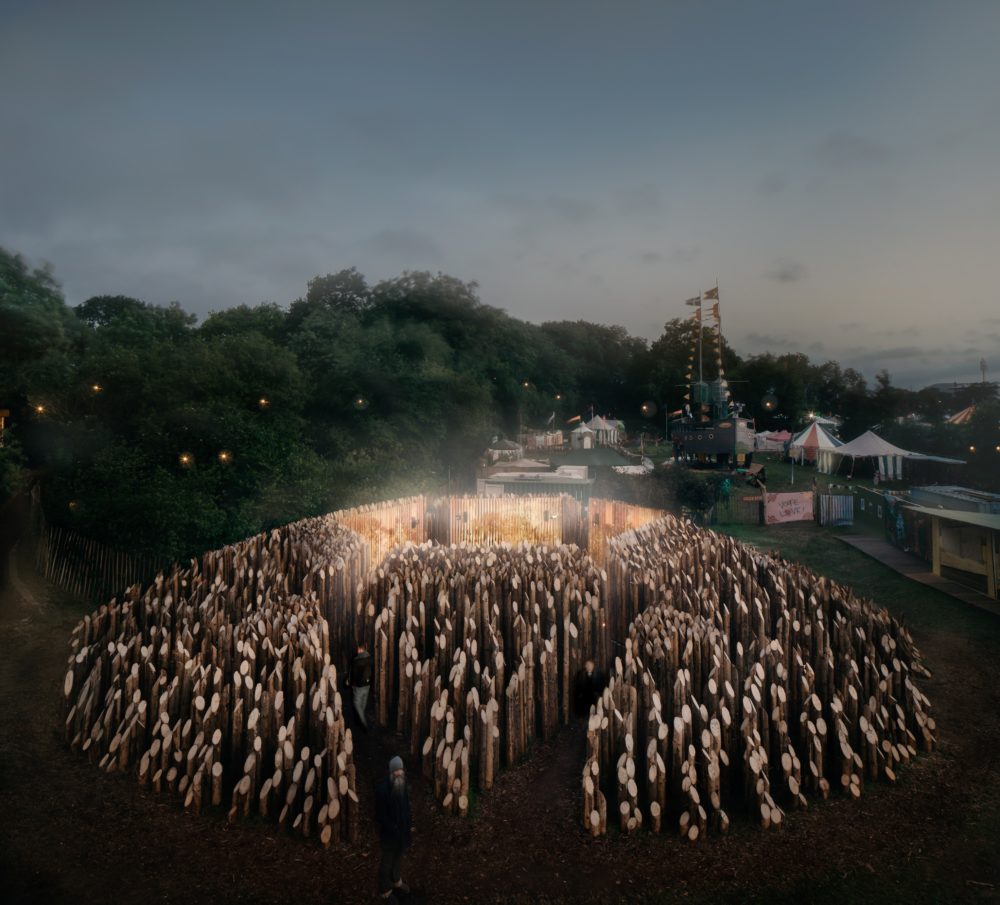This website uses cookies so that we can provide you with the best user experience possible. Cookie information is stored in your browser and performs functions such as recognising you when you return to our website and helping our team to understand which sections of the website you find most interesting and useful.
BSW Timber were very proud to be part of this year’s Glastonbury festival through their sponsorship of the BEAM installation in the Greenpeace Field.
This year the Greenpeace Field at Glastonbury festival presented a 30m diameter woodland dome pavilion made from over 7000 locally sourced and unprocessed Sitka Spruce posts. BEAM is a sculptural installation by artist Wolfgang Buttress who is well known for his multi award winning Hive sculpture at the Royal Botanic Gardens, Kew. BEAM highlights and expresses the plight of the honey bee and the essential role they play in pollinating 30% of the food we eat.
Visitors entered the woodland pavilion through numerous pathways lined by rising tree trunks inter-planted with wildflowers leading to an 11m wide hexagonal clearing. The internal space was surrounded by 3.5m high wooden lenticular screens to create a fully immersive experience. The installation used accelerometers (vibration sensors) to measure the activity of the Cornish Black Bee colony living at Michael Eavis’ Worthy Farm at Glastonbury. These live signals were sent through to the sculpture and algorithms were used to convert these vibrational signals into ever changing lighting and sound effects 24 hours a day. The Pavilion had a legacy post-Glastonbury as a giant bee hotel. Visitors during the festival were encouraged to use hand drills to create holes in the trunks to entice solitary bees and other insects to make BEAM their new home.
The internal space was fitted with a 7.2 f surround sound system that filled the space with a fluid and responsive soundscape based on live bee sounds with harmonious musical stems crafted and curated by Wolfgang, Tony Foster and Kev Bales who form the musical collective BE. Contributions to the soundscape were made by Spiritualized, Amiina (string section for Sigur Ros), Daniel Avery, Camille Christel, Kelly Lee Owens, Coldcut and Liela Moss (The Duke Spirit). Bees hum in the key of C and typically the ever evolving soundscape responds to this. Musicians performing at Glastonbury were encouraged to write and record musical stems with the live sound of the bees in a recording studio next to the sculpture which was integrated into the soundscape.

New software was written by the team which sampled real time sounds from adjacent Glastonbury stages which triggered a harmonious live remix where the key and BPM could be constantly refreshed within the installation.
The internal space had integrated LED screens which circumnavigate the clearing expressing the activity of the bee hives in real time. The space at night was filled with 360 degree projections from 12 state of the art laser projectors animating the walls of the clearing with footage from the honey bee hives and co-projects of Wolfgang’s scientific collaborator Dr Martin Bencsik in both high definition film, MRI and thermal imagery.
The challenges facing the bee are universal; BEAM is an artwork that expresses the intrinsic and essential relationship between bee and human; it brought together specialist collaborators in science, light, film, sound and projection mapping to create an immersive and multi-sensory experience. As promise it was one of the must-see and most talked about experiences of Glastonbury 2019.
BSW Timber and Tilhill Forestry supplied 6 trucks of 17cm top diameter 3.6m spruce logs direct from the forest to the festival site at Glastonbury.
Wolfgang Buttress and his team started building the installation in May and it was officially opened by Michael Eavis at the opening of the festival and was enjoyed by tens of thousands of visitors.
A short clip to illustrate can be viewed here:
BBC Earth also made a short film and the link is below:
The sculpture will stay on site until it starts to disintegrate in a few years’ time. This is great for the insects and bees in particular. Historically honeybees made their colonies in the old rotting trunks of trees. Man has completely changed the landscape and inhabited most of the land in the UK where bees and insects would have previously lived. We have a symbiotic relationship with the honey bee: they need us to provide hives, we need them to pollinate our food. Of around 250 species of bee found in the UK, the vast majority are solitary bees. Unlike honeybees and bumblebees, solitary bees don’t live together in colonies. A solitary female bee makes her nest alone.
The intention is that holes will be drilled into the timber posts in BEAM to encourage solitary bees and other pollinators to live inside it after the festival. Insects like dark rotting places to make their homes. When BEAM has decomposed to a point where it needs to be taken down, the logs will be stacked in a field to encourage more insects to live. This will probably be in 3- 5 years where it will have served its purpose as a bee hotel.
More information about the project and the artist Wolfgang Buttress can be found at: www.wolfgangbuttress.com




